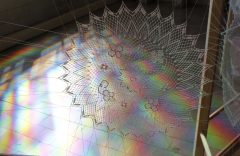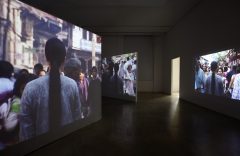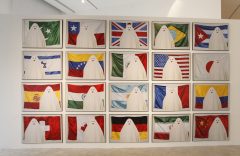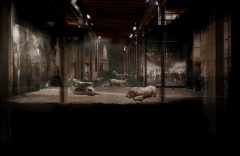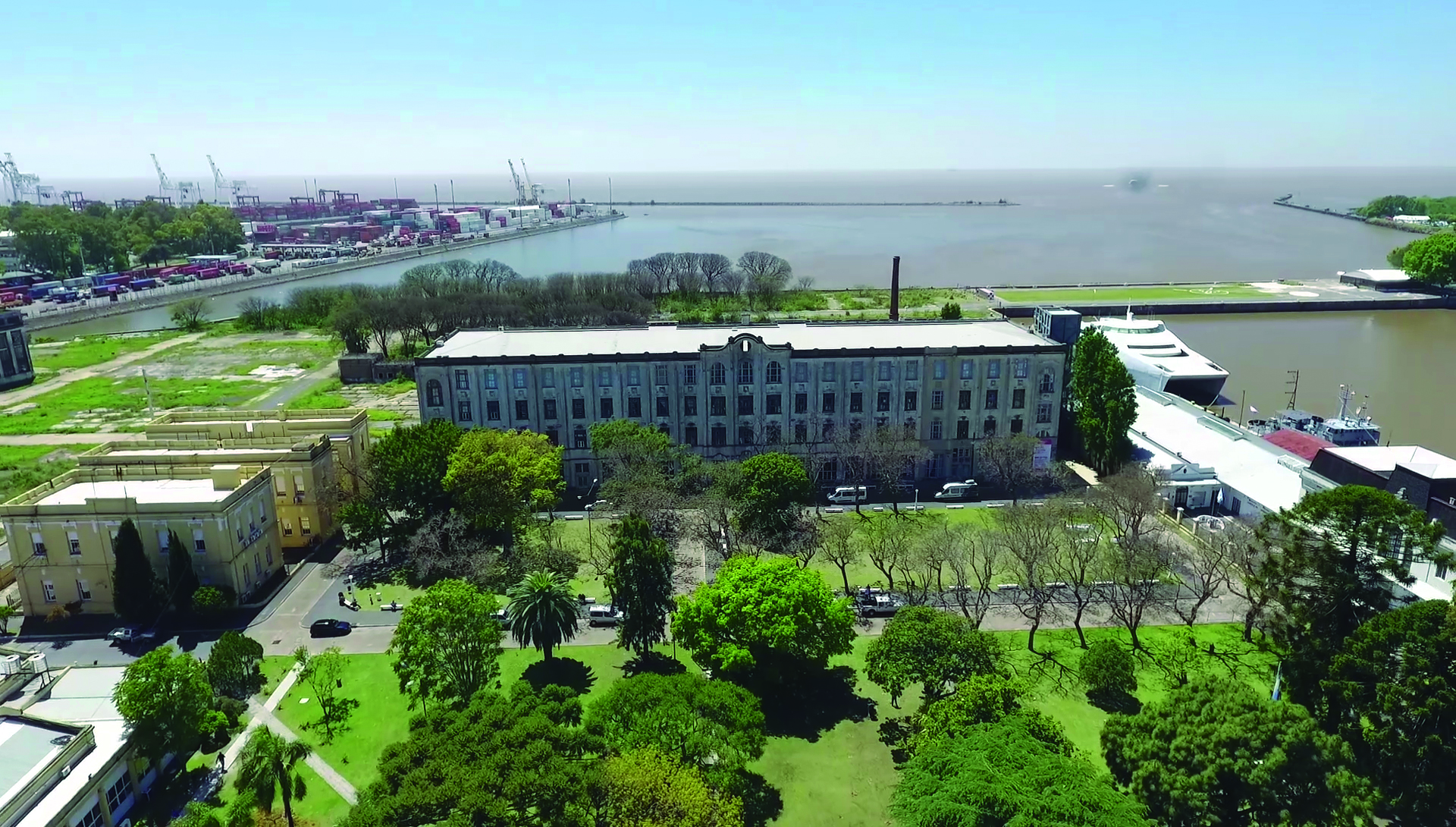
These will feature outstanding international artists and curators such as, the French Barbara Cassin, the Polish Bozena Czubak, the Korean Kimsooja, the Japanese Nelo Akamatsu, the American-German William Forsythe, and the German Mariele Neudecker, among them.
After a year dominated by the coronavirus pandemic and an almost global quarantine, the Museum of the Universidad Nacional de Tres de Febrero (MUNTREF) has prepared ten new projects for 2021 with the participation of important international artists and curators.
During the first semester, the project After Babel – Translations from the Río de la Plata—curated by French linguist Barbara Cassin with the collaboration of Marina Aguerre and Leandro Martinez Depietri, from Dr. Norberto Griffa Institute for Research in Art and Culture (IIAC-UNTREF)—will be exhibited at the MUNTREF Contemporary Art Center, Immigrants Hotel headquarters.
The exhibition, which is the result of a three-year joint research based on a proposal from the French Institute, addresses the issue of translation understood as a political tool and as a practice that values differences. With two previous actions in Marseilles and Geneva, the exhibition that will open here is an unprecedented version that reflects on the problems characterizing translation in our context, in a wide-ranging journey that goes from colonial times to the present day.
Thanks to the collaboration of national, provincial, municipal institutions, and private collections, After Babel – Translations from the Río de la Plata (Después de Babel: traducciones rioplatenses) intermixes more than 500 objects of different formats, promoting a dialogue between historical documents, texts, publications, and pieces from the field of the visual arts. The project includes works by renowned artists such as, Antonio Berni, Grete Stern, León Ferrari, Marta Minujín, Quino, Marie Orensanz, Xul Solar, Zineb Sedira, Gustave Doré, and Giovanni Battista Piranesi, as well as documents, texts, and translations by Domingo Faustino Sarmiento, Edgar Allan Poe, Ezra Pound, Sigmund Freud, Homer, James Joyce, Jorge Luis Borges, Juan Domingo Perón, Juan Manuel de Rosas, and Victoria Ocampo, among many others.
Also on view at the same venue, there will be the video installation Proyecto Panóptico Frontera 601, a work by Argentine artist Nora Ancarola that explores the processes of border militarization and the violence instituted by state power against the migrant population, as well as the criminalizing archetypes generated by the media, political, and legal spheres.
Completing the exhibitions of the first half of the year, the MUNTREF Visual Arts Museum will be showing Constellations (Constelaciones), a selection of videos from the French Regional Fund for Contemporary Art (FRACS) that deals with current issues such as gender and transit migration. Although the exhibition was installed at the beginning of 2020, the irruption of covid-19 made it necessary for the venue to close its doors. It will be the opportunity, then, to come face to face with the creations of video artists, such as Harun Farocki, Martha Rosler, Annabelle Amoros, Hicham Berrada, Joseph Dadoune, and several others.
For the second semester of 2021, MUNTREF’s programming will focus on the International Biennial of Contemporary Art of the South – BIENALSUR, produced by UNTREF, having the Immigrants Hotel venue as its Zero Kilometer. There will be housed the works of Korean Kimsooja and American-German William Forsythe, two group exhibitions which are part of the curatorial project of Polish Bozena Czubak, together with another project dedicated to contemporary migrations, curated in Argentina by the artistic director of MUNTREF and art-academic director of BIENALSUR, Diana Wechsler, along with Colombian Alex Brahim and Italian Benedetta Casini.
Meanwhile, the MUNTREF Art and Science Center will present a sound project by Japanese artist Nelo Akamatsu, whereas the MUNTREF Museum of Visual Arts will present a curatorial narrative that proposes other genealogies for the history of Argentine art based on collections like that of the Pettoruti Museum and the MUNTREF, along with interventions by contemporary artists. Finally, at the MUNTREF Art and Nature Center, a project on two shores between England and Argentina will be developed, featuring the German artist residing in the United Kingdom, Mariele Neudecker, and the academic coordinator of this MUNTREF venue, Pablo La Padula.
MUNTREF Immigrants Hotel Venue, which houses the Contemporary Art Center and the Immigration Museum, will be closed during January and will reopen on Thursday, February 4. Visits can be made from Thursdays to Sundays between 12 p.m. and 6 p.m., prior reservation through the Museum View MUNTREF app available at Google Playstore and App Store, or by writing to the e-mail visitasmuntref@untref.edu.ar. These will be carried out under the sanitary protocol stipulated by the Argentine Network of Museums and Art Spaces (RAME) and approved by the Buenos Aires and national governments.
Despite the pandemic, MUNTREF’s programming has not been stopped.
At the beginning of 2020, MUNTREF proposed a program focused on two aspects: to make progress in increasing the visibility of women artists and to deepen the internationalization of our art scene.
Thus, the Contemporary Art Center hosted the exhibitions Diaries of the Soul (Los diarios del alma) by Italian Maria Lai, in collaboration with the MAXXI in Rome; Collective Memory (Memoria colectiva) by Carlota Beltrame from Tucumán; and The photographic state (El estado fotográfico) by Chilean Julia Toro, with the support of Antenna. At the same time, the Art and Nature Center hosted the site-specific show What can smoke do to iron? (¿Qué puede el humo hacerle al hierro?), the first individual exhibition in the country by Italian Bruna Esposito; and also, at the Museum of Visual Arts, everything was ready for the public to see the abovementioned “Constellations.”
The pandemic prevented the opening of the exhibitions on schedule and led to a rapid rethinking of the year’s program in virtual mode. The Museum then developed an extensive program based on the slogan #MiráMUNTREF present on its website and its social networks alike (Facebook, Instagram, YouTube and Twitter).
Since 2012, MUNTREF’s website has had a Virtual Tours format that allows visitors to explore current and past exhibitions in a self-managed way, so the work from the beginning of the pandemic did not take long. On the one hand, they were taken to the virtual platform and 360 visits of the mounted exhibitions that could not be opened to the public were generated, and at the same time other ways of living the artistic experience were activated, linking artists and projects with the historical exhibitions. This gave rise, for example, to an exhibition directly designed for virtual modality: Contemporary apostilles to an exhibition (Apostillas contemporáneas a una exposición,) with the participation of Ananké Asseff, Diana Dowek, Edgardo Rudnitzky, Liliana Porter, Matilde Marin, and Res.
#MiráMUNTREF included a vast public program with actions such as the Laboratory of Ideas, promoted by the MUNTREF Art and Nature Center and the IIAC, which during 15 meetings and with the coordination of Pablo La Padula contributed to allowing for to some of the voices foreseen to activate the programmed exhibitions, like those of Graciela Taquini, Eduardo Stupía, Vivi Tellas, Diego Bianchi, Graciela Siracusano, Bruno Mesz, and Sebastián Tedesco, among others. The initiative sought to open other ways to reflect upon, from different disciplinary horizons, the relationships we establish with the territory we inhabit in times of biological crisis.
Likewise, MUNTREF’s education department—which coordinates the workshops and visits of children, youths, and families (as well as the numerous visits of schoolchildren)—was expanded within the framework of this virtual program, becoming one more instrument for the hard work that teachers and professors had to face during this school year.
Through social networks, the department managed to expand its audience, and the same happened with the Museum View MUNTREF app. The mobile application was conceived in a broad sense, not only to book visits to the Museum, but also so that the public can access from their cell phones to notifications with all its news, virtual tours, photo galleries, videos, audio guides, multimedia contents, and journalistic notes about the different venues.
Another key moment of 2020 was the creation of the Art and Science Center’s own platform with powerful programming coordinated by Mariano Sardón, a project developed for the In Kepler’s Gardens Festival organized by the Ars Electronica Austrian cultural, educational, and scientific institute.
When the Immigrants hotel venue was reopened to the public (by the end of the year), the reunion was exciting, and the opportunity to see “in person” what had been sensed from the virtual formats generated all an insight that enriched the interest of the visitors.
News
